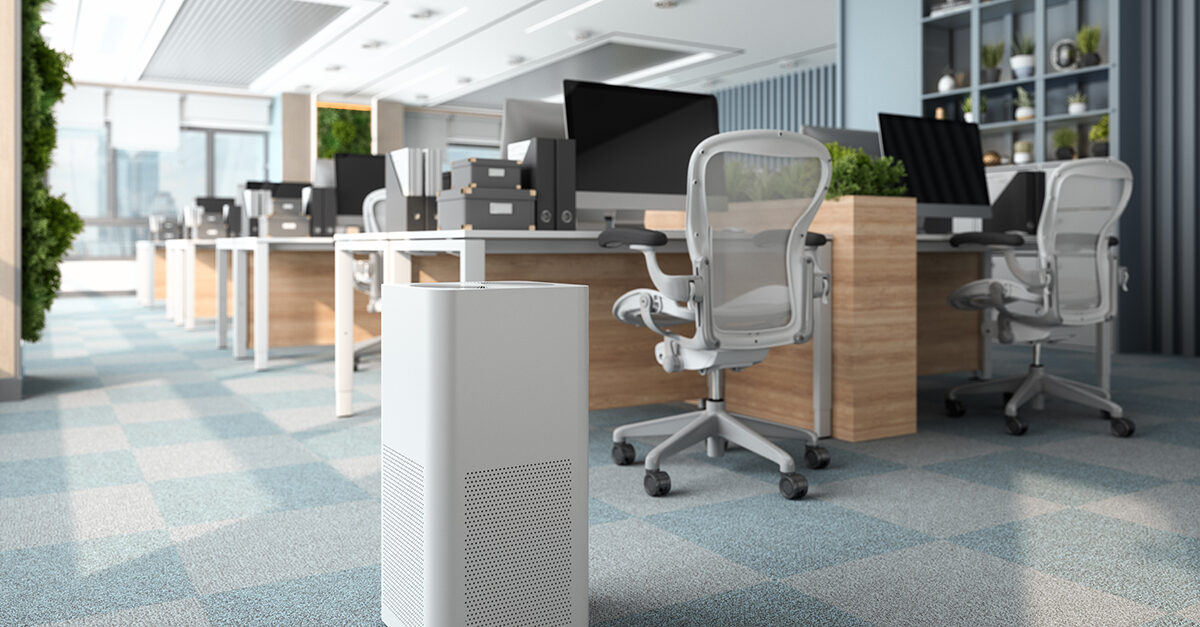Indoor air quality (IAQ) has been a problem in facilities for a long time. People who suffered from headaches, respiratory ailments, and various other symptoms when they were inside a specific facility referred to the condition as sick building syndrome caused by indoor air pollution. They often noticed their symptoms coincided with the seasonal use of heating and cooling systems.
As many modern buildings are sealed and rely on ventilation systems all year round, sufferers have gotten no relief. With an exception for health care facilities, there are no federally enforced U.S. standards for air ventilation in public buildings. The American Society of Heating, Refrigerating, and Air-Conditioning Engineers (ASHRAE) releases ventilation guidelines, but they are voluntary.
It took a global pandemic caused by the airborne SARS-CoV-2 virus to bring the issue into the limelight. In March, the Biden administration launched the Clean Air in Buildings Challenge (CABC), calling on building owners and managers to adopt strategies for improving indoor air quality.
Andy Lu, North America general manager of Blueair, a global air purification company, believes the White House’s CABC is a call to action for building owners and facility managers. “I feel it has real potential to focus building owners, operators, and leaders in assessing their indoor air quality,” he said. “What they glean from this assessment will ultimately lead to improvements in building ventilation/air filtration and increase the protection of building occupants from COVID-19.”
Dr. John McKeon, the CEO/founder of Allergy Standards Limited, a physician-led global certification company that prepares independent standards for testing products to determine their suitability for people with asthma and allergies, agrees that the CABC has the potential to make a difference, both during and after the pandemic. “I think COVID-19 has changed so many things in society. After two years of remote work will we wear neckties going forward, will we shake hands, will we kiss people on the cheek?” asked McKeon. “Before the pandemic when you spoke about indoor environments people thought about energy efficiency and sustainability. Now they’re wondering if indoor environments are healthy. The Clean Air in Buildings Challenge will bring an awareness about the importance of healthy indoor air to people and it’s something they’re going to demand going forward.”
Common indoor air pollutants
McKeon lists two main sources that contribute to indoor air pollution—the materials used in the facility and efficiency of its ventilation system. “Now that buildings are sealed for energy efficiency, air quality problems come from odors and volatile organic compounds (VOCs) from materials and products we bring in the building—carpet, furniture, paint—and how we clean and maintain them using pesticides and cleaning chemicals.”
Excessive dust and moisture left behind from improper cleaning, such as damp carpeting and floors, are other causes of poor IAQ. “Pools of water left in corners can lead to mold, and sprays that mask odors add VOCs to the air,” McKeon said.
Schools have unique pollutants contributing to poor IAQ, such as chemicals from toys, inks, paints, markers, and glues used in the classroom. “All these indoor air pollutants mix with ambient air pollution as well as contaminants from the school building itself,” Lu said. “Modern building techniques have made the building envelopes tighter in an effort to achieve energy efficiency, and air pollutants therefore tend to get trapped inside.”
Methods to clear the air
Ensuring humidity stays within the optimal range (between 30-50%) is important to prevent the damp conditions that lead to mold growth, and to avoid excessively dry air that irritates eyes and nasal passages, McKeon said. Sensor technology in smart HVAC systems will monitor moisture levels and may have built-in humidifiers and dehumidifiers that kick on when needed. Smart HVAC technology can also monitor for carbon dioxide levels and the presence of certain gases and particles in the air.
“Sensor HVAC systems go beyond thermal comfort with just heating and cooling. They also help monitor and control air quality,” McKeon said.
McKeon advises focusing on ventilation first, before filtration. “Ventilation is more important than filtration. Get the clean air in and the old air out and control the source of VOCs,” he said.
The ideal rate of air exchange is subjective, depending on the size of the facility, the number of people it holds, how it is designed, and the ceiling height, among other factors. McKeon referenced a general ASHRAE standard that recommends residential buildings receive 0.35 air changes per hour of outdoor air, but not less than 15 cubic feet of air per minute per person. Check out ASHRAE air exchange standards for all types of buildings, from schools and offices to hotels and prisons.
Consider filtration only after you’ve eliminated the source of pollution and set up proper ventilation rates. “A lot of people go to filtration too early, spending lots of money, instead of controlling the source of pollution first,” McKeon said.
A poor-quality air purifier may not only be inefficient, it may also add pollutants to the air when it breaks down the chemicals it is made to eliminate. Choose a filtration system/air purifier that is tested and certified by a third party such as the U.S. Environmental Protection Agency (EPA) or Allergy Standards.
Welcoming, healthy air
As facility managers continue to hold strict cleaning standards for their buildings, they need to show the same dedication to eliminating indoor air pollution. Just as housekeeping has gone beyond cleaning for appearance to cleaning for health, building ventilation has gone beyond keeping people cool or warm to keeping them healthy.
“If people in your building get headaches or fall asleep after lunch, they will not want to go back to their office,” McKeon said. “People want to come together, but employers need to pull them in, not push them in. Having healthy and clean air quality in your building will help pull them back in.”




